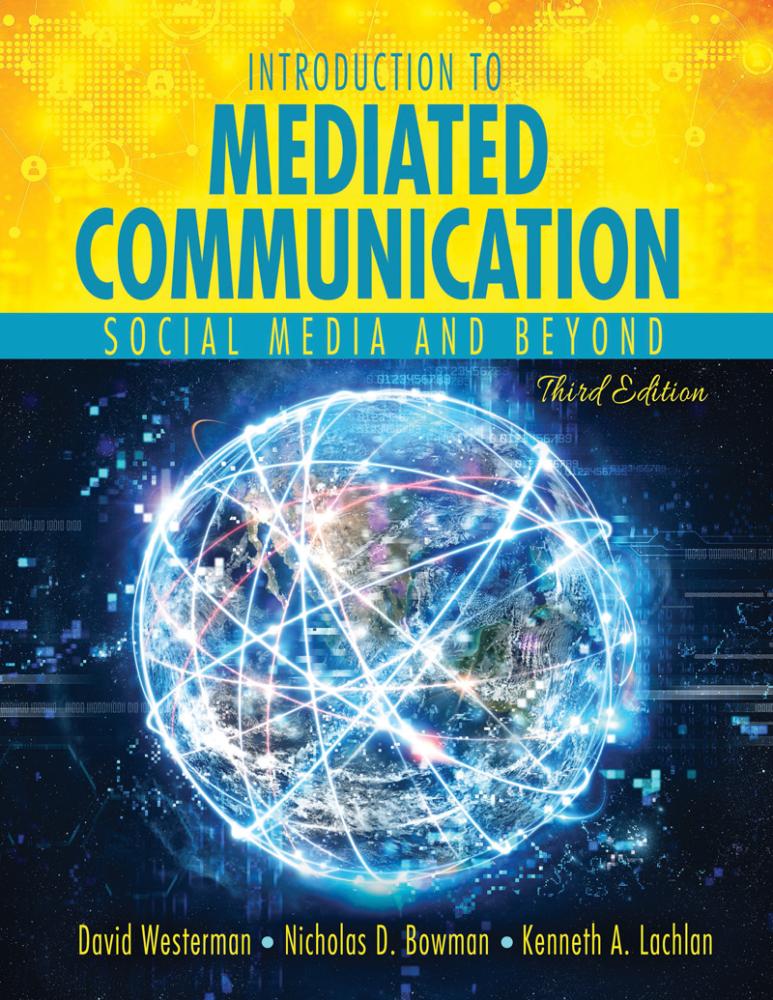Introduction to Mediated Communication: Social Media and Beyond
Author(s): David Keith Westerman , Nicholas David Bowman , Kenneth A Lachlan
Edition: 3
Copyright: 2022
Edition: 3
Copyright: 2022
Choose Your Format
Choose Your Platform | Help Me Choose
Computers allow us to do things today that were barely dreamed of 60 years ago. Today, computers and networks provide us a personal space in which we can share our innermost thoughts and feelings on a large network with others.
Introduction to Mediated Communication explains and discusses mediated communication through a functional approach - focusing attention on how people use computer technology to accomplish their communication functions.
Rather than focus on the nature of the medium itself and what sets it apart from more “traditional” media, Introduction to Computer Mediated Communication focuses on what functions people use technology for, and how people use technology to accomplish their multiple communication goals. By focusing on functions rather than channels, the publication provides instruction into the reason people use media, rather than simply discussing various technological products that will soon be outdated.
Introduction to Computer Mediated Communication by David Westerman, Nicholas David Bowman, and Ken Lachlan:
- Focuses on the degree to which new media technologies now permeate all aspects of human communication, blurring traditional distinctions between mass, interpersonal, organizational, and health communication realms.
- Analyzes how technology is used to satisfy four major reasons for communication in general: informational goals, relational goals, persuasive goals, and entertainment goals.
- Includes a regularly updated website to discuss the evolving technology. The website includes links to growing social media applications, discussions, videos, and more. And in true Web 2.0 fashion, the authors will even encourage students to participate early and often.
- Features Computer Mediated Communication in Action vignettes that apply concepts to real life scenarios and cases.
Introduction
About the Authors
Chapter 1 What Is (Mediated) Communication?
What Is Communication?
Components of Communication
Mass Mediated Communication
Interpersonal Communication
Changes in Technology Highlight Changes in Lines of Delineation
Changes in Mediated Communication
Moving toward MC
So What Is MC?
Key Terms
References
Chapter 2 What Is the Internet?
What Is the Internet?
Who Runs the Internet?
The Internet as a Social Space
Web 2.0
Key Terms
References
Chapter 3 Media as Tools
Natural-Born Cyborgs
Using Our Tools
Face to Face: Standard?
Key Terms
References
Chapter 4 Information Literacy in the Digital Age
Information Literacy
Centrality of Information Literacy in the Workplace
Digital Divides and Knowledge Gaps
The Power of Numbers
The Lesson of Wikipedia
Critical Thinking Basics
Conclusion
Key Terms
References
Chapter 5 News
What Is News?
Timeliness
Prominence
Proximity
Consequence
Human Interest
Earliest Sources of News
Jacksonian Democracy and the Birth of Objectivity
News and the Electronic Age
Broadcast versus Narrowcast versus Tailoring
Narrowcasting and Editorializing
Social Media—Are We All Media?
Citizen Journalism
Theories of Information Effects
Agenda Setting Theory
Exemplification Theory
Framing Theory
Key Terms
References
Chapter 6 Media as Educators
Mr. Rogers and the Big Bird: Learning through Television
Cognitive Learning
Affective Learning
Social Learning Theory
Video Games and Learning
Distributed Learning
Social Media and Learning
Facebook in the Classroom
Massive Open Online Courses
Key Terms
References
Chapter 7 Relationships in a Digital Age
We Are a Social Species
Online Interaction: Boon or Bane?
Social Network(ing) Sites
Deceiving Others Online
Presence: At the Heart of MC?
Why So Much Interaction?
Key Terms
References
Chapter 8 Falling in Love (or Like) Through Technology
Do We Want to Touch Everyone We See?
Building Bridges and Creating Bonds
What Is Social Networking?
Social Network Structures
Rules of Social Networks
Connection versus Influence
Networked Individualism
Building Closeness Online
Social Information Processing Theory
Key Terms
References
Chapter 9 Persuasion
Dual Process Models
Behavioral Intention Approaches
Modeling Approaches
Exemplification
Conclusions
Key Terms
References
Chapter 10 Advertising
Traditional Advertising Conventions
Facebook and Social Media Advertising
Social Media and Big Data
Multimedia Campaigning
Conclusions
Key Terms
References
Chapter 11 Campaigning
Campaigns
Public Health and Social Marketing
Relative Effectiveness
Social Marketing Works When You Are (Kind of) Scared
Narrowcasting for Those Interested
Introducing Fear, But Controlling Danger
Future of Campaigns
Conclusion
Key Terms
References
Chapter 12 Entertainment in the Digital Age
What Is Entertainment?
A History of (Mediated) Entertainment
Digitization and New Media
Compression
Conversion
Convergence
Digital Entertainment and Interactivity
Interactivity and Entertainment
Copyright Law in the Digital Age
Mobile Entertainment—Entertainment on Demand
Key Terms
References
Chapter 13 Uses and Effects of Digital Entertainment
History of Media Effects Research
The “Magic Bullet” Paradigm: 1900s to 1940s
The “Paper Tiger” Paradigm: 1940s to 1960s
Powerful, But Limited: 1960s to Today
Antisocial Effects
Violence
Violence and Interactivity
Sex, Offline and Online
Sex and New Media
Other Antisocial Media Effects
Pro-Social Effects
Health Influences
Meaningful Media Experiences
Key Terms
References
Epilogue: The Future of MC
Glossary
Index
(Ph.D., Michigan State University, 2007) is an Assistant Professor in the Department of Communication at North Dakota State University. His research and teaching focuses on communication technologies and how people use them to accomplish their goals. His research has been published in such outlets as Journal of Computer-Mediated Communication, Cyberpsychology, Behavior and Social Networking, Computers in Human Behavior, and Internet and Higher Education. Dave is currently enjoying the beautiful climate of Fargo, North Dakota with his wife Catherine. He is still anxiously awaiting the day when the Buffalo Sabres finally can hoist Lord Stanley’s Cup.
(Ph.D., Michigan State University) is an Associate Professor of Journalism and Creative Media Industries at Texas Tech University. His research focuses on the psychological and sociological impacts of communication technologies—specifically digital media—and how these impacts have influenced the human communication process. Nick has authored or co-authored nearly four dozen original empirical studies and a dozen book chapters on the subject, with much of his work focused on video games and social media applications. He currently serves on the editorial board of several research journals, including Media Psychology and New Media & Society, is an editor with Journal of Media Psychology , and contributes regularly as a reviewer for the American Library Association’s CHOICE Magazine. In 2016, he was awarded a WVU Foundation Outstanding Teacher award, and was also named a 2016 Eberly College of Arts and Sciences Outstanding Teacher. In 2020, he was named Fulbright Wu Jing-Jyi Arts and Culture Fellow by the Foundation for Scholarly Exchange in Taipei, Taiwan.
Nick is a native of St. Louis, where he split his time between the bohemian bustle of University City and the creeks and hollers of suburban-rural Jefferson County. After graduating from the University of Missouri-St. Louis (B.A., ’03; M.A., ’04) he worked as a newspaper reporter and in government relations before leaving the state to pursue his doctorate. He currently lives in the heart of Morgantown, West Virginia with his partner—in research, in the lab, and in life—Jaime. Both are avid travelers and collectors of history and popular culture artifacts, and when they’re not in the office (physically or digitally), they can usually be found on the road, searching the country (here or abroad) for remnants of entertainment culture past and present to add to their expanding collection of comic books, video games, and movie posters.
Ken Lachlan is Associate Professor at the Department of Communication at the University of Connecticut. Prior to his academic career, he worked in public radio and television promotions for several years. His research interests include the psychological effects of mass media, health and risk communication, social robotics, and new media technologies. Recent publications have appeared in the Computers in Human Behavior, Media Psychology, and the Journal of Applied Communication Research, to name a few. Ken considers himself mostly a quantitative scholar, preferring experimental and survey methodologies in investigating his areas of interest. He has also served as a consultant statistician for various companies and government agencies. He holds a dual B.A. in Communication and Sociology from Wake Forest, an M.A. in Mass Communication from Bowling Green State University, and a Ph.D. in Communication from Michigan State. An avid jogger and diehard hockey fan, Ken lives in Hartford, CT with his wife and their cat.
Computers allow us to do things today that were barely dreamed of 60 years ago. Today, computers and networks provide us a personal space in which we can share our innermost thoughts and feelings on a large network with others.
Introduction to Mediated Communication explains and discusses mediated communication through a functional approach - focusing attention on how people use computer technology to accomplish their communication functions.
Rather than focus on the nature of the medium itself and what sets it apart from more “traditional” media, Introduction to Computer Mediated Communication focuses on what functions people use technology for, and how people use technology to accomplish their multiple communication goals. By focusing on functions rather than channels, the publication provides instruction into the reason people use media, rather than simply discussing various technological products that will soon be outdated.
Introduction to Computer Mediated Communication by David Westerman, Nicholas David Bowman, and Ken Lachlan:
- Focuses on the degree to which new media technologies now permeate all aspects of human communication, blurring traditional distinctions between mass, interpersonal, organizational, and health communication realms.
- Analyzes how technology is used to satisfy four major reasons for communication in general: informational goals, relational goals, persuasive goals, and entertainment goals.
- Includes a regularly updated website to discuss the evolving technology. The website includes links to growing social media applications, discussions, videos, and more. And in true Web 2.0 fashion, the authors will even encourage students to participate early and often.
- Features Computer Mediated Communication in Action vignettes that apply concepts to real life scenarios and cases.
Introduction
About the Authors
Chapter 1 What Is (Mediated) Communication?
What Is Communication?
Components of Communication
Mass Mediated Communication
Interpersonal Communication
Changes in Technology Highlight Changes in Lines of Delineation
Changes in Mediated Communication
Moving toward MC
So What Is MC?
Key Terms
References
Chapter 2 What Is the Internet?
What Is the Internet?
Who Runs the Internet?
The Internet as a Social Space
Web 2.0
Key Terms
References
Chapter 3 Media as Tools
Natural-Born Cyborgs
Using Our Tools
Face to Face: Standard?
Key Terms
References
Chapter 4 Information Literacy in the Digital Age
Information Literacy
Centrality of Information Literacy in the Workplace
Digital Divides and Knowledge Gaps
The Power of Numbers
The Lesson of Wikipedia
Critical Thinking Basics
Conclusion
Key Terms
References
Chapter 5 News
What Is News?
Timeliness
Prominence
Proximity
Consequence
Human Interest
Earliest Sources of News
Jacksonian Democracy and the Birth of Objectivity
News and the Electronic Age
Broadcast versus Narrowcast versus Tailoring
Narrowcasting and Editorializing
Social Media—Are We All Media?
Citizen Journalism
Theories of Information Effects
Agenda Setting Theory
Exemplification Theory
Framing Theory
Key Terms
References
Chapter 6 Media as Educators
Mr. Rogers and the Big Bird: Learning through Television
Cognitive Learning
Affective Learning
Social Learning Theory
Video Games and Learning
Distributed Learning
Social Media and Learning
Facebook in the Classroom
Massive Open Online Courses
Key Terms
References
Chapter 7 Relationships in a Digital Age
We Are a Social Species
Online Interaction: Boon or Bane?
Social Network(ing) Sites
Deceiving Others Online
Presence: At the Heart of MC?
Why So Much Interaction?
Key Terms
References
Chapter 8 Falling in Love (or Like) Through Technology
Do We Want to Touch Everyone We See?
Building Bridges and Creating Bonds
What Is Social Networking?
Social Network Structures
Rules of Social Networks
Connection versus Influence
Networked Individualism
Building Closeness Online
Social Information Processing Theory
Key Terms
References
Chapter 9 Persuasion
Dual Process Models
Behavioral Intention Approaches
Modeling Approaches
Exemplification
Conclusions
Key Terms
References
Chapter 10 Advertising
Traditional Advertising Conventions
Facebook and Social Media Advertising
Social Media and Big Data
Multimedia Campaigning
Conclusions
Key Terms
References
Chapter 11 Campaigning
Campaigns
Public Health and Social Marketing
Relative Effectiveness
Social Marketing Works When You Are (Kind of) Scared
Narrowcasting for Those Interested
Introducing Fear, But Controlling Danger
Future of Campaigns
Conclusion
Key Terms
References
Chapter 12 Entertainment in the Digital Age
What Is Entertainment?
A History of (Mediated) Entertainment
Digitization and New Media
Compression
Conversion
Convergence
Digital Entertainment and Interactivity
Interactivity and Entertainment
Copyright Law in the Digital Age
Mobile Entertainment—Entertainment on Demand
Key Terms
References
Chapter 13 Uses and Effects of Digital Entertainment
History of Media Effects Research
The “Magic Bullet” Paradigm: 1900s to 1940s
The “Paper Tiger” Paradigm: 1940s to 1960s
Powerful, But Limited: 1960s to Today
Antisocial Effects
Violence
Violence and Interactivity
Sex, Offline and Online
Sex and New Media
Other Antisocial Media Effects
Pro-Social Effects
Health Influences
Meaningful Media Experiences
Key Terms
References
Epilogue: The Future of MC
Glossary
Index
(Ph.D., Michigan State University, 2007) is an Assistant Professor in the Department of Communication at North Dakota State University. His research and teaching focuses on communication technologies and how people use them to accomplish their goals. His research has been published in such outlets as Journal of Computer-Mediated Communication, Cyberpsychology, Behavior and Social Networking, Computers in Human Behavior, and Internet and Higher Education. Dave is currently enjoying the beautiful climate of Fargo, North Dakota with his wife Catherine. He is still anxiously awaiting the day when the Buffalo Sabres finally can hoist Lord Stanley’s Cup.
(Ph.D., Michigan State University) is an Associate Professor of Journalism and Creative Media Industries at Texas Tech University. His research focuses on the psychological and sociological impacts of communication technologies—specifically digital media—and how these impacts have influenced the human communication process. Nick has authored or co-authored nearly four dozen original empirical studies and a dozen book chapters on the subject, with much of his work focused on video games and social media applications. He currently serves on the editorial board of several research journals, including Media Psychology and New Media & Society, is an editor with Journal of Media Psychology , and contributes regularly as a reviewer for the American Library Association’s CHOICE Magazine. In 2016, he was awarded a WVU Foundation Outstanding Teacher award, and was also named a 2016 Eberly College of Arts and Sciences Outstanding Teacher. In 2020, he was named Fulbright Wu Jing-Jyi Arts and Culture Fellow by the Foundation for Scholarly Exchange in Taipei, Taiwan.
Nick is a native of St. Louis, where he split his time between the bohemian bustle of University City and the creeks and hollers of suburban-rural Jefferson County. After graduating from the University of Missouri-St. Louis (B.A., ’03; M.A., ’04) he worked as a newspaper reporter and in government relations before leaving the state to pursue his doctorate. He currently lives in the heart of Morgantown, West Virginia with his partner—in research, in the lab, and in life—Jaime. Both are avid travelers and collectors of history and popular culture artifacts, and when they’re not in the office (physically or digitally), they can usually be found on the road, searching the country (here or abroad) for remnants of entertainment culture past and present to add to their expanding collection of comic books, video games, and movie posters.
Ken Lachlan is Associate Professor at the Department of Communication at the University of Connecticut. Prior to his academic career, he worked in public radio and television promotions for several years. His research interests include the psychological effects of mass media, health and risk communication, social robotics, and new media technologies. Recent publications have appeared in the Computers in Human Behavior, Media Psychology, and the Journal of Applied Communication Research, to name a few. Ken considers himself mostly a quantitative scholar, preferring experimental and survey methodologies in investigating his areas of interest. He has also served as a consultant statistician for various companies and government agencies. He holds a dual B.A. in Communication and Sociology from Wake Forest, an M.A. in Mass Communication from Bowling Green State University, and a Ph.D. in Communication from Michigan State. An avid jogger and diehard hockey fan, Ken lives in Hartford, CT with his wife and their cat.






